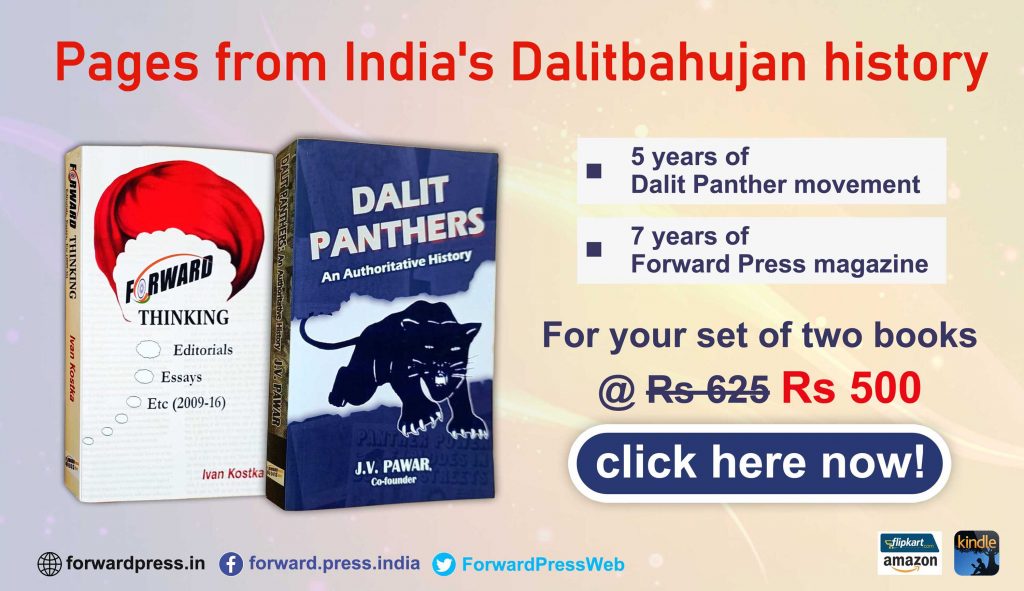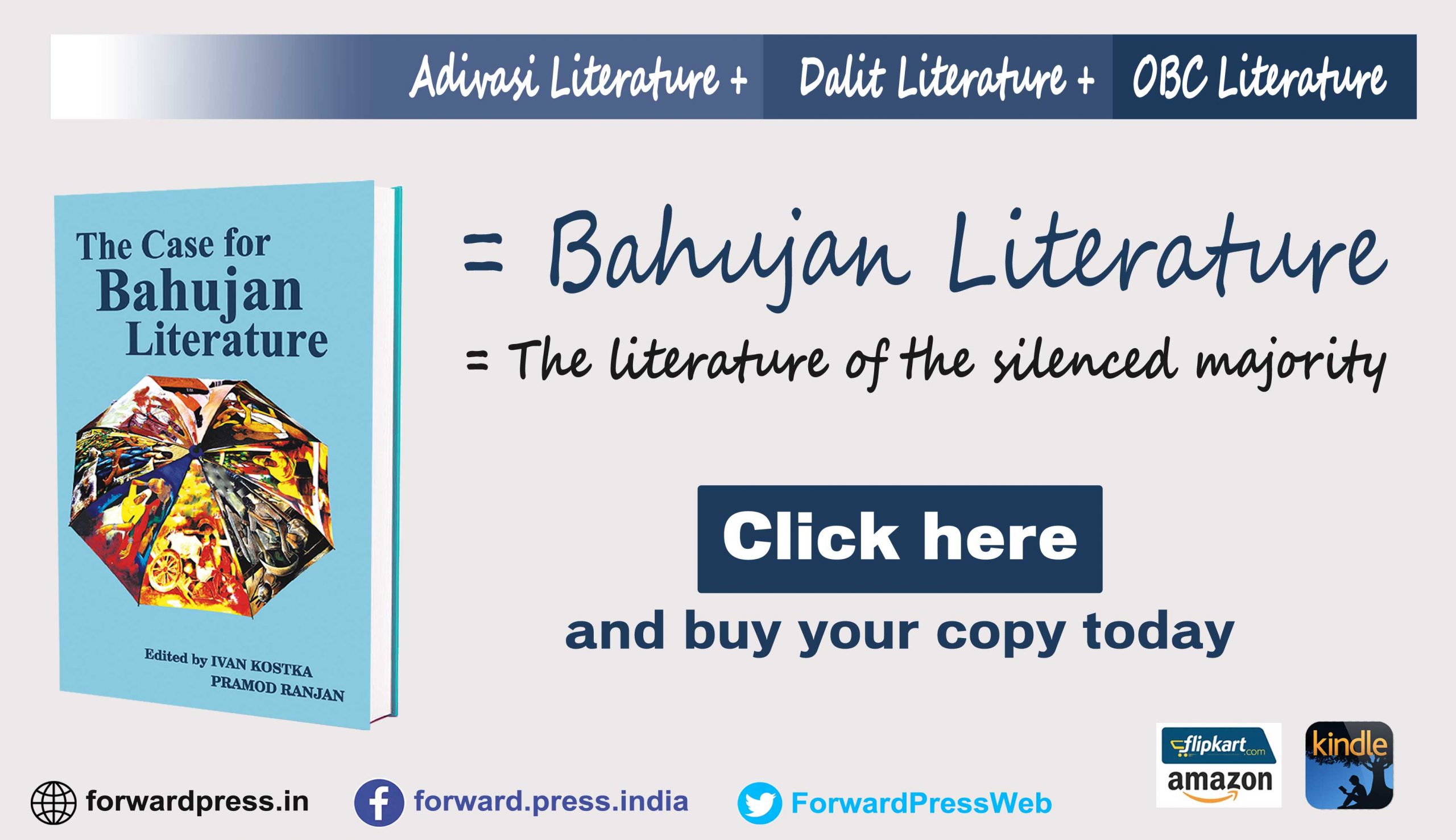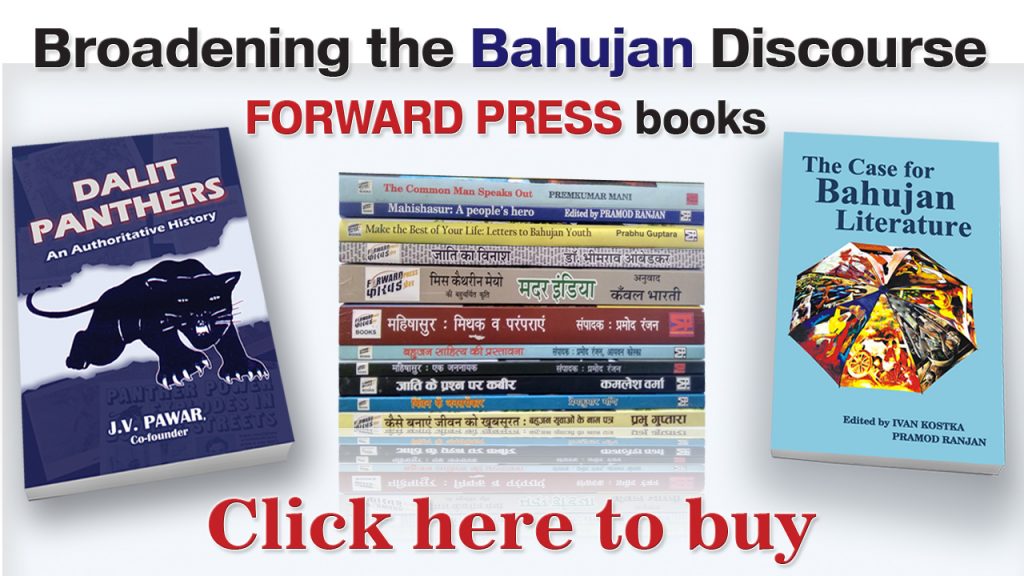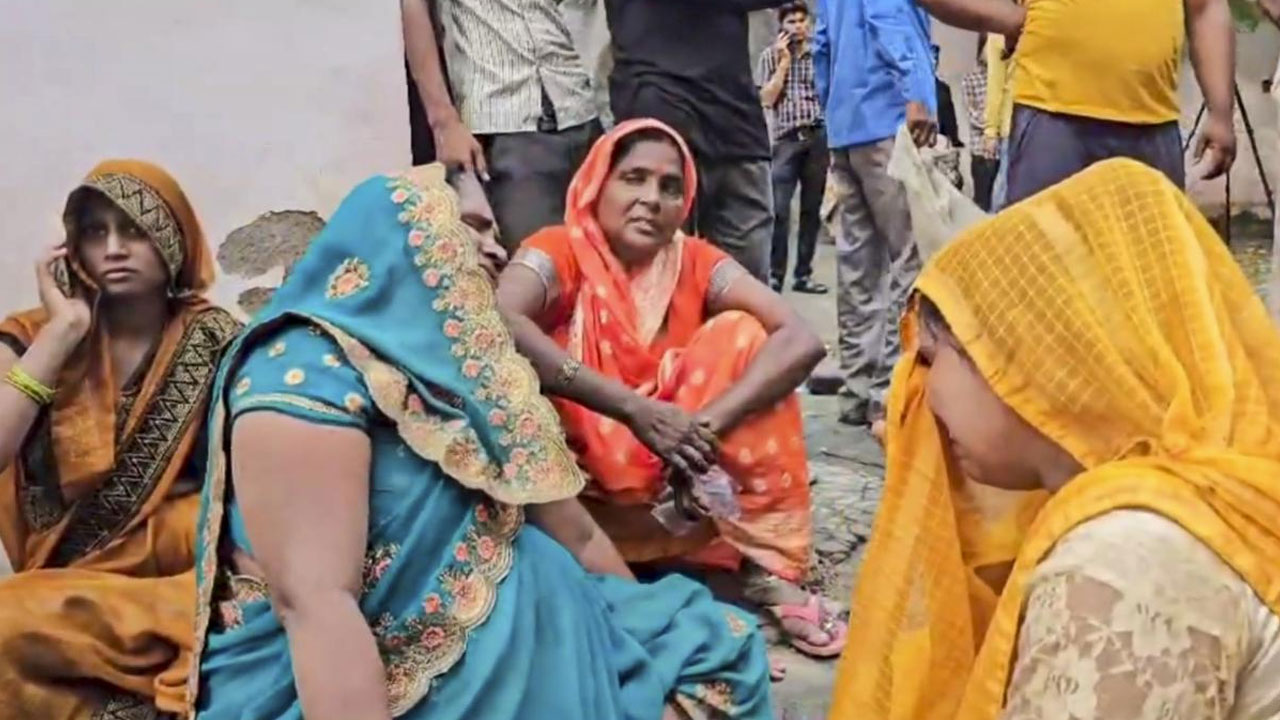My perspective is that of an alert reader who used to read the editorials of Rajendra Yadav. And this alert reader’s aesthetics is not the aesthetics of Hindi literature but that of Dalit Literature. That is the reason he finds himself in conflict with saffronism, progressivism and Marxism. Rajendra Yadav had a dislike for saffronism and I am no different. Yadav, however, agreed with progressivism and Marxism on many issues but I don’t. To my mind, the ‘Brahmin factor’ is common to all these three isms. Brahmins dominate all of them. The saffron Brahmin, the progressive Brahmin and the socialist (or Marxist) Brahmin oppose each other, as a consequence of which saffronism has been gaining strength by the day. We can witness here what Kabir described as “Jhoothe ke ghar jhootha aaya” (A liar visits a liar’s place). The three Brahmins rebut each other but behind the curtains, they are one. Only two people could catch the Brahmins out on the shrewd games they played – Kabir in the 15th century and Ambedkar in the 20th. Both refused to accept Brahmins as intellectuals and disavowed their intellectual leadership.
Rajendra Yadav was the first Hindi author to question the Brahmins helming all the three isms. He also discovered the saffron Brahmin hiding behind progressivism and Marxism and attacked him left, right and centre. It was only Yadav who could catch the saffron Brahmin lurking inside the likes of Prabhash Joshi, Nirmal Verma, Kamleshwar, Namvar Singh, Ramvilas Sharma and Ashok Vajpayee. Prabhash Joshi supported the burning alive of a woman in the name of ‘sati’. But his comment on the Naina Sahni Tandoor incident was heart-rending. The Brahmin inside Prabhash Joshi was essaying two roles simultaneously – that of a Hindu and of a human being. Yadav immediately wrote a letter to Prabhash Joshi, questioning this contradiction. “Do you find the same human sensitivity, moral outrage and noble compassion in you vis-à-vis Roop Kanwar? The pieces of Naina Sahni’s body were coated with butter and burnt in the tandoor of Bagiya. Roop Kanwar was made to sit on the pyre; ghee, samidha, etc were poured on her; and she was burnt alive. Does this incident not perturb you only because it was performed to the accompaniment of Sanskrit slokas and as a religious ritual? The only difference was that while the tandoor was fired with coal, the pyre must have been made of sandalwood and sanctified by mantras. There was politics behind both the incidents. If Roop Kanwar’s murder was not inhuman, why is Naina Sahni’s murder inhuman? Is it only because the former incident has the word ‘sati’ associated with it and enjoys the sanction of the world’s greatest religion?” (Hans, September 1995, “Agni Parikshayein’).
Rajendra Yadav caught hold of the saffron Brahmin inside the Marxist thinker Dr Ramvilas Sharma. He wrote, “In the treatises of Dr Ramvilas Sharma, we don’t find a worldview. We only find reverence for his own scholarship and for the beliefs of his blue-blooded ancestors.” (May 1995, “Brahman samaj mein jyon achoot”). He had written this article on the death of Bhairav Prasad Gupta, in which he ranked Ramvilas Sharma lower than Gupta. He even wrote, “The deep Vedic knowledge of Ramvilas ji will provide the biggest ammunition to the Hindutvavadis” (Ibid).
In the same editorial, he wrote that the works of D.D. Kosambi, Dr Ramsharan Sharma and Dr B.R. Ambedkar filled him with the excitement of acquiring a new worldview. I can say that among the mainstream Hindi writers only Rajendra Yadav had the penetrating vision that allowed him to feel this excitement. Neither Ramvilas Sharma nor Namvar Singh had this vision.
Rajendra Yadav had this vision because his writings had an agenda – not of reforming society but of transforming it. This agenda was centred on the issues of emancipation of Dalits, Adivasis and women. This agenda left the so-called great Hindi writers in the lurch, for they considered the thought process of the gentry to be the mainstream thought process. When Rajendra Yadav began building the real mainstream, their delusions were shattered and the ground beneath their feet slipped. Ashok Vajpayee, Nirmal Verma, Vidyaniwas Mishra, Naresh Mehta and Shailesh Matiyani – all were blown away like straws. Yadav showed each one of them their place. Ashok Vajpayee immediately issued a dire warning that literature was dying. Rajendra Yadav turned back and asked him, “Kahan hai Sahitya?” (March 2006). “Where is literature? It will die only if it is there.” With brutal frankness he said, “If being unconcerned with social changes and wallowing in the past is what pure literature is all about, how will it save itself in this age of information revolution? The only way we can hope to survive is to gather 50-100 people who will write and read for themselves. Or, we can keep on lamenting that literature is dying and that it is we who are somehow preserving its purity.”
A decade earlier, berating Vidyaniwas Mishra, Naresh Mehta and Shailesh Matiyani for their love for the past, Yadav wrote, “There is no question of them peeking out of their comfort zone of self-adulatory cultural obscurantism.” (March 1996, “Haare huye vijeta”). In the same article, he unmasks the pseudo progressivism of Nirmal Verma. “Staring from the Hindu Varna system, Nirmal Verma is not only a strong votary of all the idiocies, superstitions, miracles, bullheadedness, inhumanity and social rot existent in the country but he also sees a great cultural heritage in them – that heritage whose glowing descriptions is being churned out by the Dharma-factory of Kalyan Press day and night.”
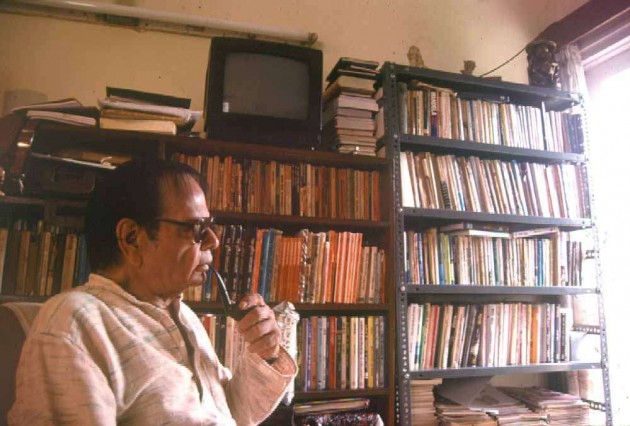
Here is a man who clearly identified the Brahmin lurking inside these writers and, like Kabir, told this to their face, “Tera mera manua kaise ik hoyee re, main kahta hon aankhan dekhi, tu kahta kagad ki likhi.” (How can our minds meet? I say what I see with my eyes. You say what is written in books.)
Yadav saw this weakness for the written word in Namvar Singh, his friend of 50 years. Yet, he did not once falter in asking, “Kaun hai ye Namvar ke bhes mein?” (Who is this man in Namvar’s guise?) (September 2009). A decade earlier, he had described Namvar Singh as an “intellectual call girl”. Only a friend can know a man inside out! Only someone who has his ears close to the ground can possess the sharp, penetrating vision which Yadav had. Kabir had it. He could identify the Brahmin within Shakts, Vaishnavs, Yogis, Jangams, Mundits, Sanyasis and even in the mullahs. That is why Kabir is called “Parakh Dharmi”. It was Yadav’s penetrating vision which made him say, “These days, for Namvar Singh, it doesn’t matter whether he is releasing the poems of Atal Bihari Vajpayee or of Varvara Rao … Adding a dash of revolution to the concoction of adulation of those in power is a good recipe.” He compared Namvar Singh with a neta ji in one of Harishankar Parsai’s short stories, who considers severing his neck as no one has put a garland around it for seven days. And Yadav doesn’t mince his words. “Namvar ji must be feeling uneasy if he doesn’t get to chair a function for two days.” There was a similar pandit in Kabir’s times who sat haughtily in the court and everyone was desperate to take diksha from him. Such pandits made Kabir laugh. Namvars of the world made Rajendra Yadav laugh. Kabir’s couplet goes like this:
Ati puneet oonche kul kahiye, sabha maanhi adhikayee
Inse dichchha sab koyee maange, hansi aave mohin bhayi
Namvar Singh evoked the same kind of laughter among the youth at a seminar organized by Hans in which he launched an acerbic attack on “young litterateurs and their moral values”. He didn’t behave like an intellectual at all. “I tell you Rajendra, don’t encourage these buggers. They will chew your hand.” What kind of impression would a scholar using such pedestrian words leave?
Such Namvars are a dime a dozen in Hindi literature. Yadav could recognize them easily. In March 1997, he wrote his editorial on such Namvars. It was titled, “A country of ostriches and scarecrows”. The piece was about the people who, when faced with a danger, dig their heads in sand like ostriches. They think that it would save them from danger. But the fact is that they are unable to gauge the danger.
This a thought-provoking editorial comment which takes note of the obliviousness of the Hindi writers to social concerns and to issues pertaining to the emancipation of the Dalits and the women. We can call it the self-struggle of Hans. Analyzing Hindi literature written between 1850 and 1950, he questions why in this entire period, there was no Dalit among the writers and why, barring a few exceptions, no woman writer raised the issue of emancipation of women.
He termed Hindi renaissance as Hindu revival, which doesn’t want to abolish the Varna system and is not in favour of any social reform. He writes, “Why is the entire corpus of Hindi literature before the advent of Marxism so hollow and superficial and why doesn’t it oppose or resist anything? Barring some exceptions, the writings are dead and status quoist.” I would like to add here that the chroniclers of Hindi literature ignored the Dalit tradition. Then, how could Yadav have known about it! In any case, Hazariprasad Dwivedi had already committed the misdeed of transforming Kabir into Gagan Bihari Vaishnav.
This editorial includes a very telling comment on Chhayavaad (neo-romanticism). “Chhayavaad is a revolt against Brahmins donning the tilak, choti and janeu occupying universities.” This comment was true as none of the Chhayavaadi writers were associated with any university. However, it is more meaningful in the sense that the domination of the Brahmins donning tilak, choti and janeu in universities was inculcating undemocratic values in the students of literature. His most thought-provoking comment was, “Due to the brahmanical terror, openness could never become a hallmark of Hindi literature.” Is there any other modern Hindi mainstream writer who has rejected the intellectual leadership of the Brahmins calling it anti-human?
He wrote, “Reverence is the biggest foe of knowledge.” It was reverence which disallowed questioning brahmanical knowledge. Had Marxist and Dalit streams of thought not emerged, the Hindi literary world would have remained entirely devoid of new knowledge and new discourses. Yadav is not wrong when he says, “Marxism scientifically reinterpreted the ideas of god, family (women) and the economics of society. That is the reason an attempt was made to push it out of the country, branding it ‘un-Indian’.” In the same context, negating the maxim Satyamev Jayate, Yadav wrote, “If truth alone triumphs, the Turks, the Mughals and the British defeated us, so was truth with them? It must have been. Otherwise, how could they have triumphed?” (January 1996, ‘Ishwar hi Satya he’)
In August 1996, Yadav made a very scathing comment on the degradation of Hindi journalism. The context was MP Phoolan Devi stopping the Shatabdi Express at Tundla railway station. Hindi newspapers had raised such a hue and cry over the incident as if Phoolan Devi hadn’t only stopped but also looted the Shatabdi Express. Yadav wrote, “Not a day passes without a minister, MP or MLA not stopping ‘Rajdhanis’ and ‘Shatabdis’. These trains are made to wait at the outer signal for hours. Flights are delayed. Krishna Kumar is witness to minister Kalpnath Rai keeping the same Shatabdi waiting for three hours at the Delhi Railway Station, but no newspaper kicks up a row when such things happen. Only yesterday, there was a news story buried in a corner that Prannoy Roy, the darling of the media, took two of his dogs to Bombay in a First Class (AC) compartment. Had Phoolan or Ramvilas Paswan done that, it would have made newspaper headlines.
He did not pull punches in baring the Savarna mindset of Hindi journalism. “The Hindi press seems to have a special love for Phoolan Devi. It is not able to forgive Phoolan Devi for getting elected as an MP. Nor is it able to digest the making of a film on her. She is repeatedly confronted with her past. It is said that Phoolan had shot dead 20 people who had nothing to do with she being raped or paraded naked. If she has done that, it is definitely a heinous and serious crime. But only four days ago, Anand Mohan’s Ranvir Sena murdered 25 men, women and children in a similar manner in Bihar. Why is the Hindi press not equally perturbed by it? Is it because all of them were poor and Dalits? Bal Thackeray, who caused the death of thousands of Muslims, is not a murderer but an incarnation of Shivaji and deserves to be worshipped and idolized.”
His April 1966 editorial titled “Shatranj Ke Khiladi” not only delineates his journalistic vision but also his ideology. Reading it feels like watching a film. A long caravan of half-clad slaves carrying loads on their backs is trudging along. Armed men astride horses are whipping them mercilessly. They are carrying material to build a palace or a temple or probably a place for entertainment. Suddenly, the enemy attacks the caravan. The armed contingent accompanying the slaves take on the enemy forces and is on the verge of defeating them when the slaves throw off their loads and join the enemy. Yadav writes, “This scene is a metaphor for the history of thousands of years of India, which is run over by a handful of invaders from one end to the other. Only one class of society resists them. The three other classes sit idle. One is reciting aartis, singing bhajans and ringing bells in temples, beseeching the gods to help them. The other is busy protecting its businesses and its farm lands. They are unconcerned with who wins or who loses. The fourth and the biggest class is getting freedom from its ‘national slavery’ through the invaders.”
This is the bitter truth of Indian history, which the savarnas don’t want to understand. Yadav also quotes Mayawati as having said that “we” had ensured the victory of Mahmud of Ghazni. “We” means the Untouchables. Dr Ambedkar writes in “The Untouchables and the Pax Britannica” that the British captured India with the help of the Untouchables and that the Untouchables helped them crush the revolt of 1857. Yadav is right when he says that the Dalits helped the British because they wanted freedom from the slavery of the Hindus.
In the same article, Yadav categorically demolishes what Arun Shourie says about Dr Ambedkar. He writes, “Brilliant Bajrangi journalist Arun Shourie, in a series of articles in Panchjanya, has described how, when the entire nation was immersed in the freedom struggle, Ambedkar was hobnobbing with the British; that this upset the people so much that they blackened Ambedkar’s face during a meeting in Poona. It is surprising that Arun Shourie cannot see the long tradition of singing paeans to the British by worthies ranging from Raja Rammohan Roy to Bhartendu, Maithilisharan Gupta and Dinkar. The British were the first rulers of India who promised impartial justice and social equity to their subjects and Dalit leaders felt that if British left the country, Savarna Hindus would never free them from their clutches. This may not be the ‘national truth’ but it is definitely the historical truth that while the Savarna Hindus saw in the British rule the potential of protecting them from the Mleccha Muslims, the Dalits saw in it a chance for freedom from the brahmanical slavery. The former were committing treason voluntarily while the latter were doing it out of compulsion. It is pathetic that Shourie, instead of looking at the cancer within, is drawing such conclusions.” This editorial goes on to analyze the constructs of V.S. Naipaul and the infiltration of multinational speculators into India.
Also read: This is your time, not mine: Rajendra Yadav
In June 2006 he wrote, “Wish I was a traitor”. If even a short excerpt from this editorial is read out on some Aastha or Sanskar channel or in the public meetings of Asarams or Murari Bapus, the country will burn. “Let’s presume that it was not the British colonizing India but us. And we were ruling India from somewhere far away. What would have been the scene in India? There is no doubt that where we lived would not have been a part of this world. We would have been living in Treta or Dwapar or some other mythological era. We would have thrust our ancient feudal culture and civilization on our ‘colony’. We would have looted lakhs and crores of rupees from here and deposited it in Swiss banks. We would have taken out such massive religious yatras from the north to the south and from the east to the west that it would have left Shankaracharya and Changez Khan green with envy. Sati, female foeticide, dowry killings and human sacrifices would have been the norm. Mass killings of the Dalits and those of other religions would have been the order of the day. The air would have resonated with the slogans eulogizing the 33 crore gods and goddesses … All around, people would be hailing the Vedas, the Brahmins and the cows. Shrieks of Shambuks, sacrifices of the thumbs of Eklavyas and the burning of their habitations would have spread happiness all around.” It is this kind of thinking that sets Yadav apart from thousands of other writers. Neither is this description of India as a Hindu colony a mere flight of fancy. The history of Hindutva is founded on these constructs. This fantastical Hindu colony shows how British rule modernized India and made it more humane and equitable. Yadav writes, “We would be the most ungrateful nation in the world if we said that the British did not modernize us.”
While the Savarna Hindi writers either try to play with words while writing on sensitive subjects like religion or prefer to keep quiet, Rajendra Yadav was so aggressive and so vocal that his well-wishers sometimes feared that someone might announce a bounty on his head. His comment in the October 2006 issue of Hans made his readers fear for his safety. In his editorial titled “Vande Mataram kee/ko dhunein” he hauled the Bajrangis on coal for announcing that they would attack the Loreto School in Lucknow because someone in the school had performed a “miracle” attributed to Jesus Christ. In those days, a madcap IAS officer, having quit his job, was roaming around Lucknow dressed as Radha. Yadav was not the one to keep quiet. He wrote, “It doesn’t matter if someone dances and sings on the streets dressed up as Radha but how can a miracle in the name of Christ be tolerated?” He did not stop at that. He also attacked religious beliefs and miracles. “Religious faith drives the construction of temples costing billions with donations and sacrifices of the devout. It helps create a reign terror of sadhus, sants and Brahmins, who don’t do any work and live off the toil of others, and of god. It frees the two and a half to three crore criminals and gluttons called sadhus, who have supposedly shun the world, from worrying about their material needs. Provisions are made for satisfying their sexual urge. Do their miracles help solve the problems facing the country? Did they ever stop a drought or a flood? Did they stop a crime from being committed? Did they grow crops in a dried-up field? Did they send back a tsunami? Did they extract electricity from rivers and oil from the earth?” he asks. Then, he says, “When I see these bullheaded opponents of wisdom, reason, science and welfare of the masses, I feel that if I had an AK-47 I would make them stand in a line and help them attain moksha. After all, the core issue for them is freedom from the material world.” One cannot but salute this man. There is at least someone among the crowd of crores who is concerned about those earning by the sweat of their brows.
In 1995, the country witnessed another miracle – the Ganesh idols drinking milk. At the time (November 1995, ‘Khamosh Ganesh ji doodh pee rahe hain’), he wrote something of great significance. “Ganesh ji drank lakhs of tons of milk and went to sleep. The religion, for thousands of years, has been proclaiming that the prasad you offer to god determines the blessings you get. For such a religion, isn’t considering getting your work done by paying bribes as a social, moral and administrative crime is in itself a cultural crime?”
Maqbool Fida Husain passed away in London. He could not breathe his last in the country that he loved so much. When, in 1996, the Hindu Taliban vandalized the Hussain-Doshi ni Gufa in Ahmedabad and burnt down the paintings of Husain, Rajendra Yadav came out in Husain’s support in the November 1996 issue of Hans. When Husain acquired the citizenship of Qatar, Yadav, in his editorial (April 2010) titled ‘Bhumandal ka sand aur banjh sarkaar’ wrote something which only a Dalit-OBC writer could have written. No Savarna writer could have done that. “Neither Chidambaram nor Manmohan Singh can even touch wolves like Thackeray or Imam Bukhari.” Where is another Hindi writer who could describe Thackeray as a wolf?
Two other editorial articles of Yadav need to be mentioned here. The first was published in March 2009 and was titled “Jahan manav bam banaye jaate hain”. The second, from May 2009, carried the title “Bahut mat puchho nachiketa, mare jaoge”. The first is on Hindutva and the second is on Islam. Here Yadav is in Kabir’s role: “Allah Ram ka gham nahin, tahan ghar kiya Kabir”. The March 2009 piece was about the Sri Ram Sene, one of the hundreds of arms of the Sangh Parivar, attacking women in a pub in Mangalore. Terming the assailants as the Taliban, he asks, “Who are these people who have opened slaughterhouses to save religion and culture?” Only Rajendra Yadav could have asked, “What kind of morality is this that keeps quiet on all kinds of frauds, hypocrisies and lies but starts hissing like a snake the moment it sees a woman? Who are these demons who want to confine women to a pen like helpless animals so that they themselves can ‘kill’ them?”
Sheeba Fahmi was consistently writing on the problems of Muslim women in her column ‘Parda Idhar Parda Udhar’ in Hans. Her articles on four marriages and divorce were powerful. But she sought solutions to all the problems within the limits of the Quran and the Hadis. She was not ready to go beyond them. Yadav’s critics always used to chide him that he couldn’t dare attack Islam in the way he attacked Hindutva. He answered his critics through his editorial published in May 2009. The questions he posed to Sheeba were such that even contemplating them would be blasphemous for a Muslim. Rare would be a Hindu who would be able to ask such questions. Only a Kabir can ask such questions – a Kabir who is neither a Hindu nor a Muslim. Yadav asks Sheeba, “Can’t you free yourself from the Quran, Shariat and Hadis?” One doesn’t know whether Sheeba had read “aoo billahi …” but Rajendra Yadav had definitely become a Kabir. The questions he asked were far from ordinary. “Don’t you think the interpretations of the Shariat norms are unable to solve the problems of today … these interpretations become the guide for the Taliban and create Fidayeen? Or else, what religious sanction do they have for whipping a 17-year-old girl in public or killing someone by raining stones on them?” With Kabir’s forthrightness, Yadav asks, “Madam, my question is, how long will we quote what is written ‘there’ to prove our point?” And he then goes on to relate the two lines of Kabir to Sheeba, “main kahta hon aankhan dekhi, tu kahta kagad ki lekhi”.
In my view, Rajendra Yadav’s “aankhan dekhi” social reality makes him the greatest thinker of our times.
(Translation: Amrish Herdenia; copy-editing: Anil)
Forward Press also publishes books on Bahujan issues. Forward Press Books sheds light on the widespread problems as well as the finer aspects of Bahujan (Dalit, OBC, Adivasi, Nomadic, Pasmanda) society, culture, literature and politics. Contact us for a list of FP Books’ titles and to order. Mobile: +917827427311, Email: info@forwardmagazine.in)
The titles from Forward Press Books are also available on Kindle and these e-books cost less than their print versions. Browse and buy:
The Case for Bahujan Literature
Dalit Panthers: An Authoritative History
